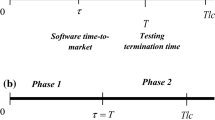Abstract
In a Software Development Life Cycle the testing phase is given a lot of importance. But testing cannot be done indefinitely due to many reasons ranging from marketing considerations to increase in cost. Hence it is pertinent to find the optimal release time during testing phase. Firms routinely face the challenging decision of when to stop testing and release the product in the market. It has been observed that the pace of introduction of new software is much higher in recent years in comparison to any time in the past. Thus to get the competitive edge it is critical to know about the optimal entry time. Too late an entry is likely to lead to significant loss of opportunity. On the other hand early introduction of a product might hinder its growth due to lack of receptiveness of users towards new technology. Many release time problems with optimization criteria like cost minimization, reliability maximization and budgetary constraints etc. have been discussed in the literature. The release time problem discussed in this paper depends on the combined effect of cost and the Failure Intensity function; therefore we formulated an optimal release planning problem based on multi-attribute utility theory. A numerical illustration is provided towards the end of the paper. Furthermore, a trend line for the reliability of software has also been plotted to show the behaviour of reliability.






Similar content being viewed by others
References
Bardhan AK (2002) Modelling in software reliability and its interdisciplinary nature. PhD Thesis, Department of Operational Research, University of Delhi
Ferreira RJP, Almeida AT, Cavalcante CAV (2009) A multi-criteria decision model to determine inspection intervals of condition monitoring based on delay time analysis. Reliabil Eng Syst Saf 94:905–912
Fishburn CP (1970) Utility theory for decision making. Wiley, New York
Kanoun K, Bastos M, Moreira J (1991) A method for software reliability analysis and prediction application to the TROPICO-R switching system. IEEE Trans Softw Eng 17(4):334–344
Kapur PK, Garg RB (1990) Optimal release policies for software systems with testing effort. Int J Syst Sci 22(9):1563–1571
Kapur PK, Agarwala S, Garg RB (1994) Bicriterion release policy for exponential software reliability growth model. Recherche Operationnelle Oper Res 28:165–180
Kapur PK, Garg RB, Kumar S (1999) Contributions to hardware and software reliability. World Scientific Publishing Co. Ltd., Singapore
Kapur PK, Tandon A, Kaur G (2010a) Multi up-gradation software reliability model. 2nd International conference on reliability, safety & hazard (ICRESH), pp. 468–474
Kapur PK, Garmabaki AHS, Singh J (2010b) Software reliability multi-upgradation model with imperfect debugging. International congress on productivity, quality, reliability, optimization and modelling, (ICPQROM), vol 1, pp 136–149
Kapur PK, Pham H, Gupta A, Jha PC (2011a) Software reliability assessment with OR applications. Springer, UK
Kapur PK, Anand A, Singh O (2011b) Modeling successive software up-gradations with faults of different severity. In: Hoda MN (ed) Proceedings of the 5th national conference, INDIACom 2011. Bharati Vidyapeeth’s Institute of Computer Applications and Management, New Delhi, pp 351–356
Keeney RL, Raiffa H (1976) Decisions with multiple objectives: preferences and value tradeoffs. Wiley, New York
Li X, Li YF, Xie Min, Ng SH (2011) Reliability analysis and optimal version-updating for open source software. Inf Softw Technol 53:929–936
Luo Y, Bergander T (2007) Software reliability growth modeling using weighed Laplace test statistic. Annual international conference (COMPSAC 2007), vol 2, pp 305–312
Musa JD, Iannino A, Okumoto K (1987) Software reliability: measurement, prediction, applications. McGraw Hill, New York
Neumann JV, Morgenstern O (1947) Theory of games and economic behaviour, 2nd edn. Princeton University Press, Princeton
Ohba M (1984) Software reliability analysis models. IBM J Res Dev 28:428–443
Okumoto K, Goel AL (1979) Time dependent error detection rate model for software reliability and other performance measures. IEEE Trans Reliabil 28(3):206–211
Okumoto K, Goel AL (1983) ‘Optimal release time for computer software. IEEE Trans Softw Eng SE-9(3):323–327
Pham H (2006) Software reliability. Springer, Singapore
Seung C, Zhang C (2011) Developing socioeconomic indicators for fisheries off Alaska: a multi-attribute utility function approach. Fish Res 112(3):117–126
Singh O, Kapur PK, Anand A (2011a) A stochastic formulation of successive software releases with faults severity. In: Proceedings of the IEEE international conference on industrial engineering and engineering management (IEEM), 6–9 Dec 2011, Singapore, pp 136–140
Singh O, Kapur PK, Anand A, Singh J (2011b) Stochastic differential equation based modeling for multiple generations of software and optimal release planning. In: Proceedings of 5th international conference on quality, reliability and infocom technology (ICQRIT), trends and future 8 directions, Kathmandu, Nepal, SN-19, pc-19, 2011
Thurston DL (2006) Multi-attribute utility analysis of conflicting preferences. In: Lewis KE et al (eds) Decision making in engineering design. ASME Press, New York, pp 125–133
Winterfeldt D, Edwards W (1986) Decision analysis and behavioral research. Cambridge University Press, Cambridge
Wood A (1996) Predicting software reliability. IEEE Comput 9:69–77
Xie M (1991) Software reliability modeling. World Scientific Publishing, Singapore
Yamada S, Ohba M, Osaki S (1984a) S-shaped software reliability growth models and their applications. IEEE Trans Reliabil 33(4):289–292
Yamada S, Narihisa H, Osaki S (1984b) Optimum release policies for a software system with a scheduled software delivery time. Int J Syst Sci 15(8):905–914
Acknowledgments
The research work presented in this paper is supported by grants to the second author from Department of Science and Technology (DST) Grant No. SR/S4/MS: 600/09, India.
Author information
Authors and Affiliations
Corresponding author
Rights and permissions
About this article
Cite this article
Singh, O., Kapur, P.K. & Anand, A. A multi-attribute approach for release time and reliability trend analysis of a software. Int J Syst Assur Eng Manag 3, 246–254 (2012). https://doi.org/10.1007/s13198-012-0107-8
Received:
Revised:
Published:
Issue Date:
DOI: https://doi.org/10.1007/s13198-012-0107-8




